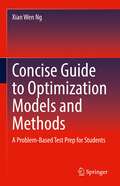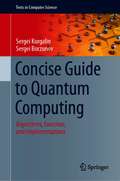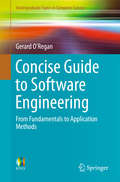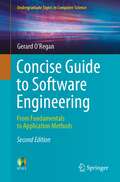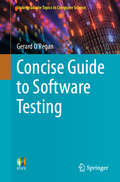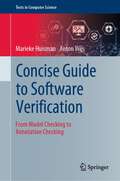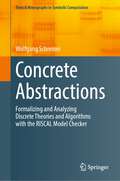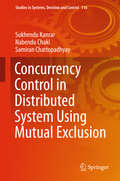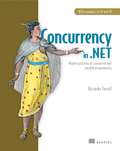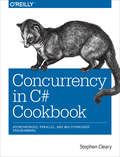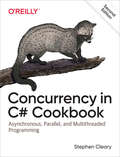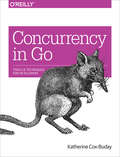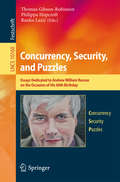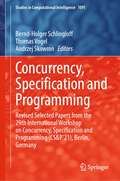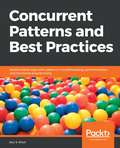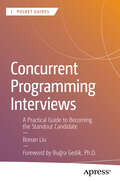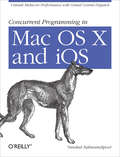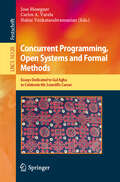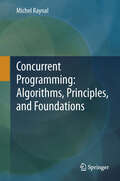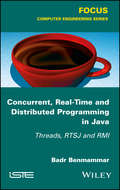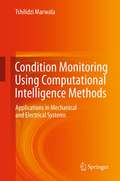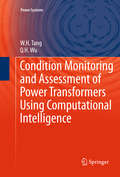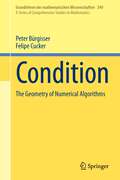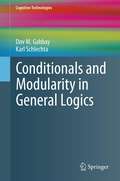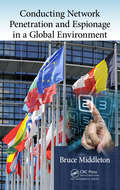- Table View
- List View
Concise Guide to Optimization Models and Methods: A Problem-Based Test Prep for Students
by Xian Wen NgThis concise text contains the most commonly-encountered examination problems in the topic of Optimization Models and Methods, an important module in engineering and other disciplines where there exists an increasing need to operate optimally and sustainably under constraints, such as tighter resource availability, environmental consideration, and cost pressures. This book is comprehensive in coverage as it includes a diverse spectrum of problems from numerical open-ended questions that probe creative thinking to the relation of concepts to realistic settings. The book adopts many examples of design scenarios as context for curating sample problems. This will help students relate desktop problem-solving to tackling real-world problems. Succinct yet rigorous, with over a 100 pages of problems and corresponding worked solutions presented in detail, the book is ideal for students of engineering, applied science, and market analysis.
Concise Guide to Quantum Computing: Algorithms, Exercises, and Implementations (Texts in Computer Science)
by Sergei Kurgalin Sergei BorzunovThis textbook is intended for practical, laboratory sessions associated with the course of quantum computing and quantum algorithms, as well as for self-study. It contains basic theoretical concepts and methods for solving basic types of problems and gives an overview of basic qubit operations, entangled states, quantum circuits, implementing functions, quantum Fourier transform, phase estimation, etc. The book serves as a basis for the application of new information technologies in education and corporate technical training: theoretical material and examples of practical problems, as well as exercises with, in most cases, detailed solutions, have relation to information technologies. A large number of detailed examples serve to better develop professional competencies in computer science.
Concise Guide to Software Engineering
by Gerard O'ReganThis essential textbook presents a concise introduction to the fundamental principles of software engineering, together with practical guidance on how to apply the theory in a real-world, industrial environment. The wide-ranging coverage encompasses all areas of software design, management, and quality.Topics and features: presents a broad overview of software engineering, including software lifecycles and phases in software development, and project management for software engineering; examines the areas of requirements engineering, software configuration management, software inspections, software testing, software quality assurance, and process quality; covers topics on software metrics and problem solving, software reliability and dependability, and software design and development, including Agile approaches; explains formal methods, a set of mathematical techniques to specify and derive a program from its specification, introducing the Z specification language; discusses software process improvement, describing the CMMI model, and introduces UML, a visual modelling language for software systems; reviews a range of tools to support various activities in software engineering, and offers advice on the selection and management of a software supplier; describes such innovations in the field of software as distributed systems, service-oriented architecture, software as a service, cloud computing, and embedded systems; includes key learning topics, summaries and review questions in each chapter, together with a useful glossary.This practical and easy-to-follow textbook/reference is ideal for computer science students seeking to learn how to build high quality and reliable software on time and on budget. The text also serves as a self-study primer for software engineers, quality professionals, and software managers.
Concise Guide to Software Engineering: From Fundamentals to Application Methods (Undergraduate Topics in Computer Science)
by Gerard O'ReganThis textbook presents a concise introduction to the fundamental principles of software engineering, together with practical guidance on how to apply the theory in a real-world, industrial environment. The wide-ranging coverage encompasses all areas of software design, management, and quality.Topics and features: presents a broad overview of software engineering, including software lifecycles and phases in software development, and project management for software engineering; examines the areas of requirements engineering, software configuration management, software inspections, software testing, software quality assurance, and process quality; covers topics on software metrics and problem solving, software reliability and dependability, and software design and development, including Agile approaches; explains formal methods, a set of mathematical techniques to specify and derive a program from its specification, introducing the Z specification language; discusses software process improvement, describing the CMMI model, and introduces UML, a visual modelling language for software systems; reviews a range of tools to support various activities in software engineering, and offers advice on the selection and management of a software supplier; describes such innovations in the field of software as distributed systems, service-oriented architecture, software as a service, cloud computing, and embedded systems; includes key learning topics, summaries and review questions in each chapter, together with a useful glossary.This practical and easy-to-follow textbook/reference is ideal for computer science students seeking to learn how to build high quality and reliable software on time and on budget. The text also serves as a self-study primer for software engineers, quality professionals, and software managers.
Concise Guide to Software Testing (Undergraduate Topics in Computer Science)
by Gerard O'ReganThis practically-focused textbook provides a concise and accessible introduction to the field of software testing, explaining the fundamental principles and offering guidance on applying the theory in an industrial environment.Topics and features: presents a brief history of software quality and its influential pioneers, as well as a discussion of the various software lifecycles used in software development; describes the fundamentals of testing in traditional software engineering, and the role that static testing plays in building quality into a product; explains the process of software test planning, test analysis and design, and test management; discusses test outsourcing, and test metrics and problem solving; reviews the tools available to support software testing activities, and the benefits of a software process improvement initiative; examines testing in the Agile world, and the verification of safety critical systems; considers the legal and ethical aspects of software testing, and the importance of software configuration management; provides key learning topics and review questions in every chapter, and supplies a helpful glossary at the end of the book.This easy-to-follow guide is an essential resource for undergraduate students of computer science seeking to learn about software testing, and how to build high quality and reliable software on time and on budget. The work will also be of interest to industrialists including software engineers, software testers, quality professionals and software managers, as well as the motivated general reader.
Concise Guide to Software Verification: From Model Checking to Annotation Checking (Texts in Computer Science)
by Anton Wijs Marieke HuismanThis textbook overviews the whole spectrum of formal methods and techniques that are aimed at verifying correctness of software, and how they can be used in practice. It focuses on techniques whereby the user has some control over the properties that are being checked. More specifically, it shows a wide range of techniques covering the whole spectrum: from abstract system design to implementation, from bug finding to full proofs, and from techniques that are push-button by design and give a yes/no answer to techniques that require the user to provide explicit guidance to steer the analysis process.Topics and features:Covers a broad spectrum of software verification techniques, from model checking to annotation checkingProvides numerous examples to demonstrate the techniquesFocuses on how techniques can be used (and the main ideas behind how they work), as opposed to how they are implementedExplains strengths and weaknesses of the techniques, providing insight into when to use which technique in practiceThis unique textbook has been written primarily for master’s level students in computer science studying embedded systems and specializing in software technology. The book will also be of interest for students studying cyber security and data science technology, as well as for system or software developers interested in techniques that offer formal guarantees about software.
Concrete Abstractions: Formalizing and Analyzing Discrete Theories and Algorithms with the RISCAL Model Checker (Texts & Monographs in Symbolic Computation)
by Wolfgang SchreinerThis book demonstrates how to formally model various mathematical domains (including algorithms operating in these domains) in a way that makes them amenable to a fully automatic analysis by computer software.The presented domains are typically investigated in discrete mathematics, logic, algebra, and computer science; they are modeled in a formal language based on first-order logic which is sufficiently rich to express the core entities in whose correctness we are interested: mathematical theorems and algorithmic specifications. This formal language is the language of RISCAL, a “mathematical model checker” by which the validity of all formulas and the correctness of all algorithms can be automatically decided. The RISCAL software is freely available; all formal contents presented in the book are given in the form of specification files by which the reader may interact with the software while studying the corresponding book material.
Concurrency Control in Distributed System Using Mutual Exclusion (Studies in Systems, Decision and Control #116)
by Nabendu Chaki Sukhendu Kanrar Samiran ChattopadhyayThe book presents various state-of-the-art approaches for process synchronization in a distributed environment. The range of algorithms discussed in the book starts from token based mutual exclusion algorithms that work on tree based topology. Then there are interesting solutions for more flexible logical topology like a directed graph, with or without cycle. In a completely different approach, one of the chapters presents two recent voting-based DME algorithms. All DME algorithms presented in the book aim to ensure fairness in terms of first come first serve (FCFS) order among equal priority processes. At the same time, the solutions consider the priority of the requesting processes and allocate resource for the earliest request when no such request from a higher priority process is pending.
Concurrency in .NET: Modern patterns of concurrent and parallel programming
by Riccardo TerrellSummaryConcurrency in .NET teaches you how to build concurrent and scalable programs in .NET using the functional paradigm. This intermediate-level guide is aimed at developers, architects, and passionate computer programmers who are interested in writing code with improved speed and effectiveness by adopting a declarative and pain-free programming style.Purchase of the print book includes a free eBook in PDF, Kindle, and ePub formats from Manning Publications.About the TechnologyUnlock the incredible performance built into your multi-processor machines. Concurrent applications run faster because they spread work across processor cores, performing several tasks at the same time. Modern tools and techniques on the .NET platform, including parallel LINQ, functional programming, asynchronous programming, and the Task Parallel Library, offer powerful alternatives to traditional thread-based concurrency.About the BookConcurrency in .NET teaches you to write code that delivers the speed you need for performance-sensitive applications. Featuring examples in both C# and F#, this book guides you through concurrent and parallel designs that emphasize functional programming in theory and practice. You'll start with the foundations of concurrency and master essential techniques and design practices to optimize code running on modern multiprocessor systems. What's InsideThe most important concurrency abstractionsEmploying the agent programming model Implementing real-time event-stream processing Executing unbounded asynchronous operationsBest concurrent practices and patterns that apply to all platformsAbout the ReaderFor readers skilled with C# or F#.About the BookRiccardo Terrell is a seasoned software engineer and Microsoft MVP who is passionate about functional programming. He has over 20 years' experience delivering cost-effective technology solutions in a competitive business environment.Table of ContentsPART 1 - Benefits of functional programming applicable to concurrent programs Functional concurrency foundationsFunctional programming techniques for concurrencyFunctional data structures and immutabilityPART 2 - How to approach the different parts of a concurrent programThe basics of processing big data: data parallelism, part 1PLINQ and MapReduce: data parallelism, part 2Real-time event streams: functional reactive programmingTask-based functional parallelismTask asynchronicity for the winAsynchronous functional programming in F#Functional combinators for fluent concurrent programmingApplying reactive programming everywhere with agentsParallel workflow and agent programming with TPL DataflowPART 3 - Modern patterns of concurrent programming appliedRecipes and design patterns for successful concurrent programmingBuilding a scalable mobile app with concurrent functional programming
Concurrency in C# Cookbook
by Stephen ClearyIf you're one of the many developers uncertain about concurrent and multithreaded development, this practical cookbook will change your mind. With more than 75 code-rich recipes, author Stephen Cleary demonstrates parallel processing and asynchronous programming techniques, using libraries and language features in .NET 4.5 and C# 5.0.Concurrency is becoming more common in responsive and scalable application development, but it's been extremely difficult to code. The detailed solutions in this cookbook show you how modern tools raise the level of abstraction, making concurrency much easier than before. Complete with ready-to-use code and discussions about how and why the solution works, you get recipes for using:async and await for asynchronous operationsParallel programming with the Task Parallel LibraryThe TPL Dataflow library for creating dataflow pipelinesCapabilities that Reactive Extensions build on top of LINQUnit testing with concurrent codeInterop scenarios for combining concurrent approachesImmutable, threadsafe, and producer/consumer collectionsCancellation support in your concurrent codeAsynchronous-friendly Object-Oriented ProgrammingThread synchronization for accessing data
Concurrency in C# Cookbook: Asynchronous, Parallel, and Multithreaded Programming
by Stephen ClearyIf you’re one of many developers still uncertain about concurrent and multithreaded development, this practical cookbook will change your mind. With more than 85 code-rich recipes in this updated second edition, author Stephen Cleary demonstrates parallel processing and asynchronous programming techniques using libraries and language features in .NET and C# 8.0.Concurrency is now more common in responsive and scalable application development, but it’s still extremely difficult to code. The detailed solutions in this cookbook show you how modern tools raise the level of abstraction, making concurrency much easier than before. Complete with ready-to-use code and discussions about how and why solutions work, these recipes help you:Get up to speed on concurrency and async and parallel programmingUse async and await for asynchronous operationsEnhance your code with asynchronous streamsExplore parallel programming with .NET’s Task Parallel LibraryCreate dataflow pipelines with .NET’s TPL Dataflow libraryUnderstand the capabilities that System.Reactive builds on top of LINQUtilize threadsafe and immutable collectionsLearn how to conduct unit testing with concurrent codeMake the thread pool work for youEnable clean, cooperative cancellationExamine scenarios for combining concurrent approachesDive into asynchronous-friendly object-oriented programmingRecognize and write adapters for code using older asynchronous styles
Concurrency in Go: Tools and Techniques for Developers
by Katherine Cox-BudayConcurrency can be notoriously difficult to get right, but fortunately, the Go open source programming language makes working with concurrency tractable and even easy. If you’re a developer familiar with Go, this practical book demonstrates best practices and patterns to help you incorporate concurrency into your systems.Author Katherine Cox-Buday takes you step-by-step through the process. You’ll understand how Go chooses to model concurrency, what issues arise from this model, and how you can compose primitives within this model to solve problems. Learn the skills and tooling you need to confidently write and implement concurrent systems of any size.Understand how Go addresses fundamental problems that make concurrency difficult to do correctlyLearn the key differences between concurrency and parallelismDig into the syntax of Go’s memory synchronization primitivesForm patterns with these primitives to write maintainable concurrent codeCompose patterns into a series of practices that enable you to write large, distributed systems that scaleLearn the sophistication behind goroutines and how Go’s runtime stitches everything together
Concurrency, Security, and Puzzles: Essays Dedicated to Andrew William Roscoe on the Occasion of His 60th Birthday (Lecture Notes in Computer Science #10160)
by Thomas Gibson-Robinson Philippa Hopcroft Ranko LazićThis festschrift was written in honor of Andrew William (Bill) Roscoe on the occasion of his 60th birthday, and features tributes by Sir Tony Hoare, Stephen Brookes, and Michael Wooldridge. Bill Roscoe is an international authority in process algebra, and has been the driving force behind the development of the FDR refinement checker for CSP. He is also world renowned for his pioneering work in analyzing security protocols, modeling information flow, human-interactive security, and much more. Many of these areas are reflected in the 15 invited research articles in this festschrift, and in the presentations at the "BILL-60" symposium held in Oxford, UK, on January 9 and 10, 2017.
Concurrency, Specification and Programming: Revised Selected Papers from the 29th International Workshop on Concurrency, Specification and Programming (CS&P'21), Berlin, Germany (Studies in Computational Intelligence #1091)
by Thomas Vogel Andrzej Skowron Bernd-Holger SchlingloffThis book presents novel approaches to the formal specification of concurrent and parallel systems, mathematical models for describing such systems, and programming and verification concepts for their implementation. A special emphasis is on methods based on artificial intelligence and machine learning techniques.Chapters are revised selected papers from the 29th International Workshop on Concurrency, Specification, and Programming (CS&P 2021), Berlin, Germany. Nine independent chapters cover formal approaches to topics such as requirements formalization, parsing, or granular computing, as well as their applications in recommender systems, decision making, security, optimization, and other areas. The book thus addresses both researchers and practitioners in its field.
Concurrent Patterns and Best Practices: Build scalable apps with patterns in multithreading, synchronization, and functional programming
by Atul S. KhotA definitive guide to mastering and implementing concurrency patterns in your applicationsKey FeaturesBuild scalable apps with patterns in multithreading, synchronization, and functional programmingExplore the parallel programming and multithreading techniques to make the code run fasterEfficiently use the techniques outlined to build reliable applicationsBook DescriptionSelecting the correct concurrency architecture has a significant impact on the design and performance of your applications. This book explains how to leverage the different characteristics of parallel architecture to make your code faster and more efficient. To start with, you'll understand the basic concurrency concepts and explore patterns around explicit locking, lock free programming, futures & actors. Then, you'll get insights into different concurrency models and parallel algorithms and put them to practice in different scenarios to realize your application's true potential. We'll take you through multithreading design patterns, such as master, slave, leader, follower, map-reduce, and monitor, also helping you to learn hands-on coding using these patterns. Once you've grasped all of this, you'll move on to solving problems using synchronizer patterns. You'll discover the rationale for these patterns in distributed & parallel applications, followed by studying how future composition, immutability and the monadic flow help create more robust code. Toward the end of the book, you'll learn about the actor paradigm and actor patterns - the message passing concurrency paradigm.What you will learnExplore parallel architecture Get acquainted with concurrency models Internalize design themes by implementing multithreading patterns Get insights into concurrent design patterns Discover design principles behind many java threading abstractions Work with functional concurrency patternsWho this book is forThis is a must-have guide for developers who want to learn patterns to build scalable and high-performing apps. It’s assumed that you already have a decent level of programming knowledge.
Concurrent Programming Interviews: A Practical Guide to Becoming the Standout Candidate (Apress Pocket Guides)
by Bonan LiuAce your software engineering job interviews by preparing yourself for the concurrent programming rounds. This book fills the gap in practical resources designated for concurrency interview prep. It simplifies complex concepts in C++ and provides example questions to help you approach your interview with confidence. Today, interviews for software engineering roles typically include several different rounds: coding, system design, behavioral, and domain knowledge. The domain knowledge round can vary based on the job description, but one extremely common focus is concurrent programming. While not intended to be a comprehensive reference, this book distills the essential interview insights drawn from author Bonan Liu’s personal experiences to stand out from the competition. Key topics include mutexes and locks, condition variables, thread abstraction, STL features, and lock-free implementations, with each concept reinforced through practical exercises like building a file handler cache and implementing read/write locks. Software interviews are more than just exams; they are hours-long conversations with real people. You'll not only develop a solid understanding of concurrency, but also learn how to best showcase your expertise to enhance your performance throughout the entire process, including general coding rounds. What You Will Learn Acquire foundational knowledge of concurrent programming in C++. Practice relevant interview questions for each section of this knowledge. Develop strategies for best demonstrating learned skills in the general coding round. Who This Book Is For Software engineers seeking new career opportunities, particularly SDE II, Senior SDE, and Staff SDE roles. Interviewers might also gain insight into concurrent programming to enhance the evaluation of their candidates, securing top talent.
Concurrent Programming in Mac OS X and iOS: Unleash Multicore Performance with Grand Central Dispatch (Oreilly And Associate Ser.)
by Vandad NahavandipoorNow that multicore processors are coming to mobile devices, wouldn't it be great to take advantage of all those cores without having to manage threads? This concise book shows you how to use Apple's Grand Central Dispatch (GCD) to simplify programming on multicore iOS devices and Mac OS X.Managing your application’s resources on more than one core isn't easy, but it's vital. Apps that use only one core in a multicore environment will slow to a crawl. If you know how to program with Cocoa or Cocoa Touch, this guide will get you started with GCD right away, with many examples to help you write high-performing multithreaded apps.Package your code as block objects and invoke them with GCDUnderstand dispatch queues—the pools of threads managed by GCDUse different methods for executing UI and non-UI tasksCreate a group of tasks that GCD can run all at onceInstruct GCD to execute tasks only once or after a delayDiscover how to construct your own dispatch queues
Concurrent Programming, Open Systems and Formal Methods: Essays Dedicated to Gul Agha to Celebrate His Scientific Career (Lecture Notes in Computer Science #16120)
by Carlos A. Varela Nalini Venkatasubramanian Jose MeseguerThis Festschrift is dedicated to Gul Agha in recognition of his outstanding research and teaching impact. Gul Agha received his undergraduate degree at Caltech in 1977 and his A.M., M.S. and Ph.D. degrees at the University of Michigan, Ann Arbor. His thesis led to the MIT Press book Actors: A Model of Concurrent Computation in Distributed Systems, a work cited nearly 5000 times. After researcher and lecturer appointments at MIT and Yale, he moved to the University of Illinois, Urbana-Champaign, where he started as an assistant professor in 1989 and subsequently become a full professor and the founding director of the Open Systems Laboratory. The team&’s goal is to develop concurrent programming languages and systems that support applications with high-performance, fault-tolerance or real-time requirements, and this work has been very influential across domains such as Software Engineering, Formal Methods, Programming Languages, Concurrency Theory, Distributed Systems, and Cyber-Physical Systems. Gul Agha is a Fellow of the IEEE and a Fellow of the ACM, other honors include the IBM Faculty Award, the ONR Young Investigator Award, and the ACM Recognition of Service Award. Over the course of his career Gul has been a highly impactful mentor, and he has collaborated in research and in publications with a wide range of scientists and engineers, in academia and in industry. Beyond his deep expertise, they have been inspired by his well-rounded intellect, philosophy of life, and sense of humor, and their successes are reflected in the papers contributed to this volume.
Concurrent Programming: Algorithms, Principles, And Foundations
by Michel RaynalThe advent of new architectures and computing platforms means that synchronization and concurrent computing are among the most important topics in computing science. Concurrent programs are made up of cooperating entities -- processors, processes, agents, peers, sensors -- and synchronization is the set of concepts, rules and mechanisms that allow them to coordinate their local computations in order to realize a common task. This book is devoted to the most difficult part of concurrent programming, namely synchronization concepts, techniques and principles when the cooperating entities are asynchronous, communicate through a shared memory, and may experience failures. Synchronization is no longer a set of tricks but, due to research results in recent decades, it relies today on sane scientific foundations as explained in this book. In this book the author explains synchronization and the implementation of concurrent objects, presenting in a uniform and comprehensive way the major theoretical and practical results of the past 30 years. Among the key features of the book are a new look at lock-based synchronization (mutual exclusion, semaphores, monitors, path expressions); an introduction to the atomicity consistency criterion and its properties and a specific chapter on transactional memory; an introduction to mutex-freedom and associated progress conditions such as obstruction-freedom and wait-freedom; a presentation of Lamport's hierarchy of safe, regular and atomic registers and associated wait-free constructions; a description of numerous wait-free constructions of concurrent objects (queues, stacks, weak counters, snapshot objects, renaming objects, etc.); a presentation of the computability power of concurrent objects including the notions of universal construction, consensus number and the associated Herlihy's hierarchy; and a survey of failure detector-based constructions of consensus objects. The book is suitable for advanced undergraduate students and graduate students in computer science or computer engineering, graduate students in mathematics interested in the foundations of process synchronization, and practitioners and engineers who need to produce correct concurrent software. The reader should have a basic knowledge of algorithms and operating systems.
Concurrent, Real-Time and Distributed Programming in Java: Threads, RTSJ and RMI
by Badr BenmammarThis book provides an introduction to concurrent, real-time, distributed programming with Java object-oriented language support as an algorithm description tool. It describes in particular the mechanisms of synchronization (cooperative and competitive) and sharing of data (internal class, static variables) between threads in Java. He then discusses the use of Java for real-time applications. Consequently, a presentation of the RTSJ (Real Time Specification for Java) specification dedicated to the development of real-time applications in Java is also introduced in this book. Finally, a presentation of programming distributed in Java is presented in this book. We are particularly interested in communication using the TCP Sockets and high-level communication using Java Remote Method Invocation (RMI). The book also contains an annex which contains a practical set of application exercises in relation to the theme of the book. Knowledge of the Java language is a prerequisite for understanding the book.
Condition Monitoring Using Computational Intelligence Methods: Applications in Mechanical and Electrical Systems
by Tshilidzi MarwalaCondition Monitoring Using Computational Intelligence Methods promotes the various approaches gathered under the umbrella of computational intelligence to show how condition monitoring can be used to avoid equipment failures and lengthen its useful life, minimize downtime and reduce maintenance costs. The text introduces various signal-processing and pre-processing techniques, wavelets and principal component analysis, for example, together with their uses in condition monitoring and details the development of effective feature extraction techniques classified into frequency-, time-frequency- and time-domain analysis. Data generated by these techniques can then be used for condition classification employing tools such as: * fuzzy systems; rough and neuro-rough sets; neural and Bayesian networks;hidden Markov and Gaussian mixture models; and support vector machines.
Condition Monitoring and Assessment of Power Transformers Using Computational Intelligence (Power Systems)
by W. H. Tang Q. H. WuIn recent years, rapid changes and improvements have been witnessed in the field of transformer condition monitoring and assessment, especially with the advances in computational intelligence techniques. Condition Monitoring and Assessment of Power Transformers Using Computational Intelligence applies a broad range of computational intelligence techniques to deal with practical transformer operation problems. The approaches introduced are presented in a concise and flowing manner, tackling complex transformer modelling problems and uncertainties occurring in transformer fault diagnosis. Condition Monitoring and Assessment of Power Transformers Using Computational Intelligence covers both the fundamental theories and the most up-to-date research in this rapidly changing field. Many examples have been included that use real-world measurements and realistic operating scenarios of power transformers to fully illustrate the use of computational intelligence techniques for a variety of transformer modelling and fault diagnosis problems. Condition Monitoring and Assessment of Power Transformers Using Computational Intelligence is a useful book for professional engineers and postgraduate students. It also provides a firm foundation for advanced undergraduate students in power engineering.
Condition: The Geometry of Numerical Algorithms (Grundlehren der mathematischen Wissenschaften #349)
by Felipe Cucker Peter BürgisserThis book gathers threads that have evolved across different mathematical disciplines into seamless narrative. It deals with condition as a main aspect in the understanding of the performance ---regarding both stability and complexity--- of numerical algorithms. While the role of condition was shaped in the last half-century, so far there has not been a monograph treating this subject in a uniform and systematic way. The book puts special emphasis on the probabilistic analysis of numerical algorithms via the analysis of the corresponding condition. The exposition's level increases along the book, starting in the context of linear algebra at an undergraduate level and reaching in its third part the recent developments and partial solutions for Smale's 17th problem which can be explained within a graduate course. Its middle part contains a condition-based course on linear programming that fills a gap between the current elementary expositions of the subject based on the simplex method and those focusing on convex programming.
Conditionals and Modularity in General Logics (Cognitive Technologies)
by Dov M. Gabbay Karl SchlechtaThis text centers around three main subjects. The first is the concept of modularity and independence in classical logic and nonmonotonic and other nonclassical logic, and the consequences on syntactic and semantical interpolation and language change. In particular, we will show the connection between interpolation for nonmonotonic logic and manipulation of an abstract notion of size. Modularity is essentially the ability to put partial results achieved independently together for a global result. The second aspect of the book is the authors' uniform picture of conditionals, including many-valued logics and structures on the language elements themselves and on the truth value set. The third topic explained by the authors is neighbourhood semantics, their connection to independence, and their common points and differences for various logics, e.g., for defaults and deontic logic, for the limit version of preferential logics, and for general approximation. The book will be of value to researchers and graduate students in logic and theoretical computer science.
Conducting Network Penetration and Espionage in a Global Environment
by Bruce MiddletonWhen it's all said and done, penetration testing remains the most effective way to identify security vulnerabilities in computer networks. Conducting Network Penetration and Espionage in a Global Environment provides detailed guidance on how to perform effective penetration testing of computer networks-using free, open source, and commercially avai
